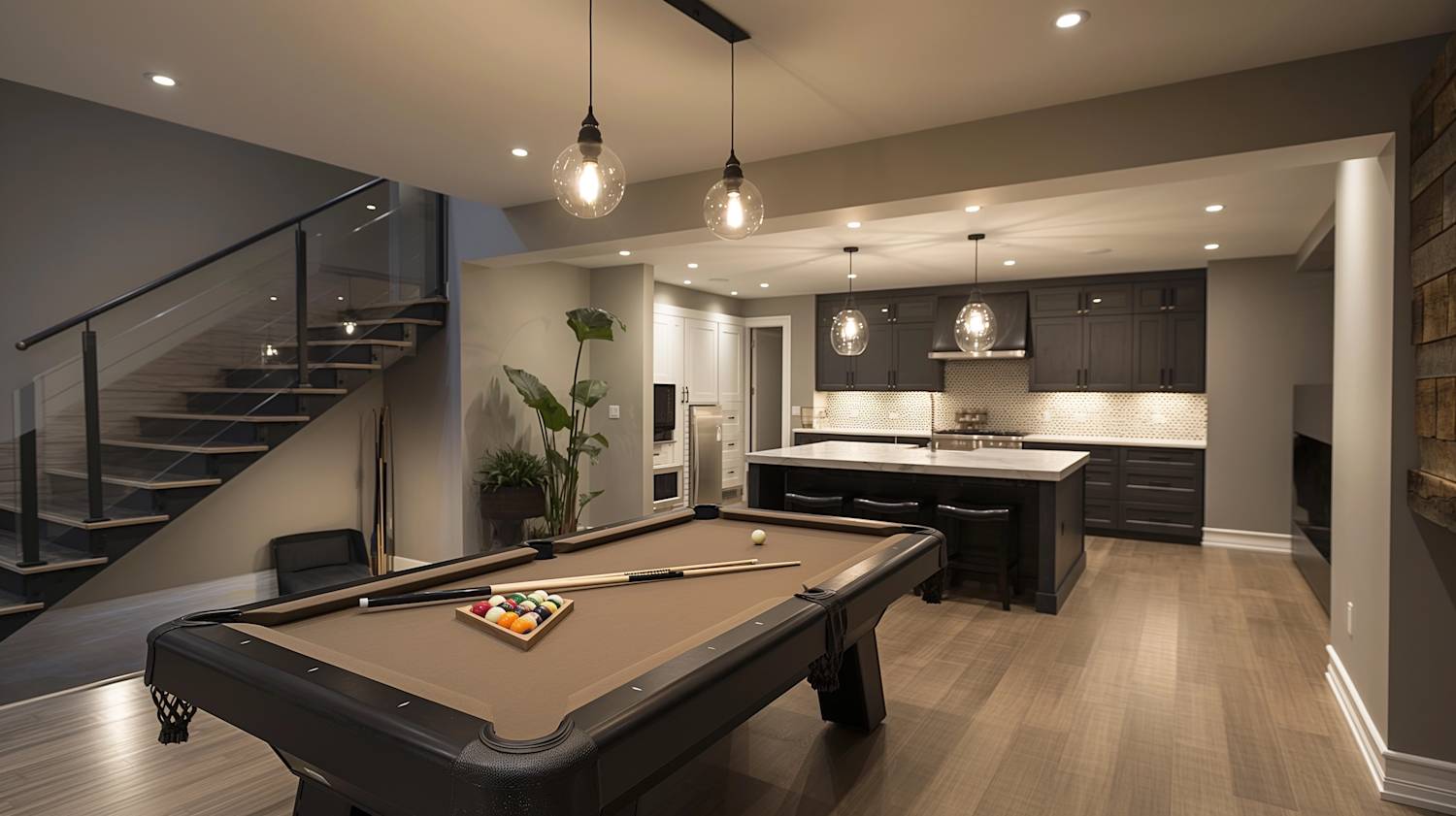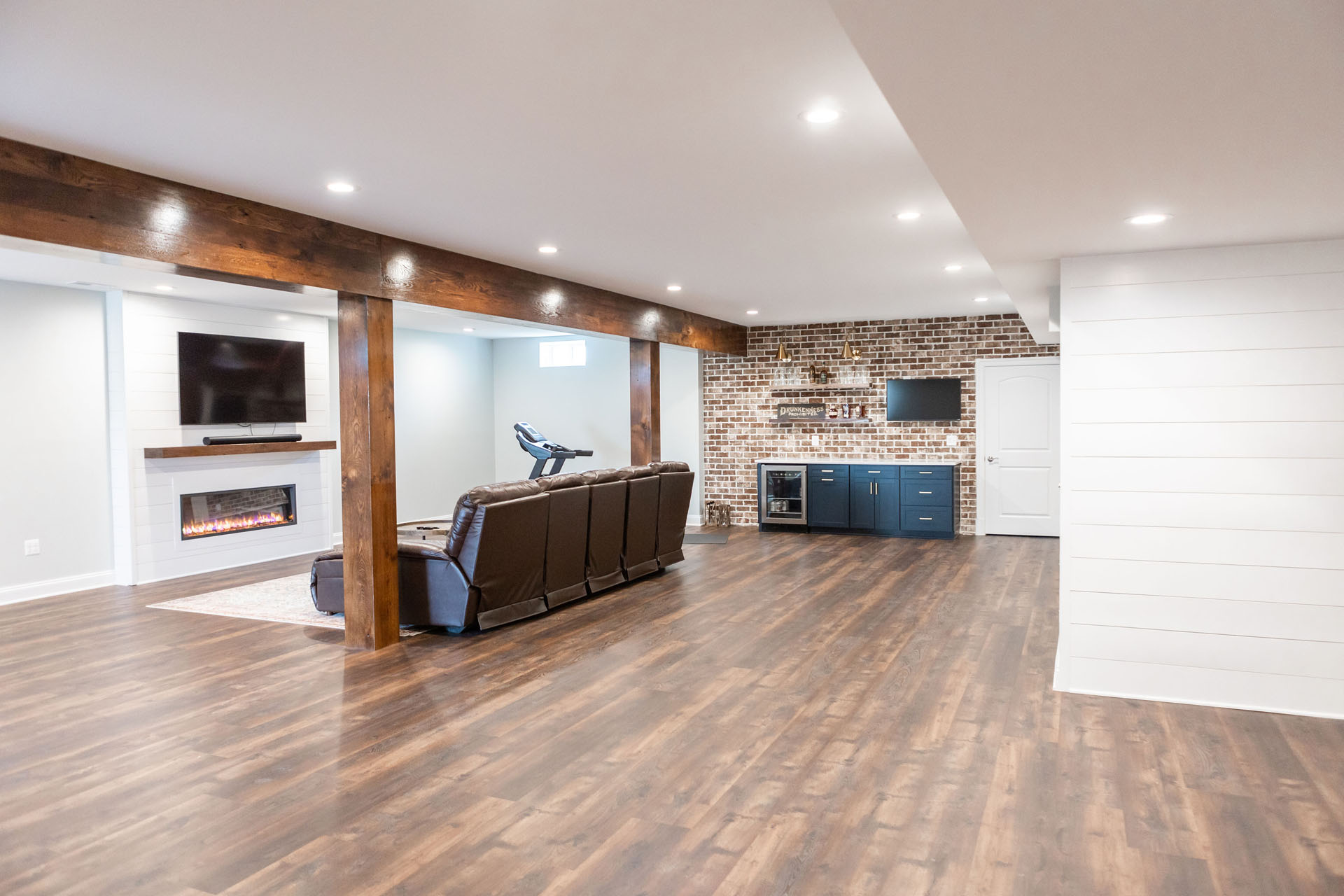Finishing a basement can transform it from a dark, unused space into one of the most functional and inviting areas of your home. Whether you’re turning it into a home theater, gym, guest suite, or playroom, lighting plays a crucial role—and recessed lighting is one of the best options for basements.
This guide covers everything you need to know about recessed lighting in a finished basement, from planning and layout tips to fixture types, installation advice, and design ideas.
Why Recessed Lighting Works Best in Finished Basements
Basements present unique lighting challenges due to:

- Low ceilings
- Lack of natural light
- Limited window access
- Uneven ceiling layouts (ductwork, soffits, beams)
Recessed lights, also called can lights or pot lights, offer a sleek, space-saving solution. Here’s why they’re ideal:
Read More: Transporting Drywall Down the Basement Stairs: A Complete DIY Guide
Space-Saving
Recessed lights sit flush with the ceiling, making them perfect for low ceiling basements.
Read More: DRICORE SMARTWALL Panels | Finishing Basement Walls Made Easy
Even Light Distribution
Properly spaced recessed lights provide consistent ambient lighting with minimal shadows.
Read More: 7ft Basement Ceiling Lighting Fixture Ideas: Smart Solutions for Low Ceilings
Versatility
They’re excellent for task lighting, accent lighting, or general illumination.
Read More: Basement Lighting: Our Top 5 Fixes for Poor Lighting
Modern Aesthetics
Recessed fixtures contribute to a clean, streamlined look, ideal for modern or contemporary designs.
Read More: Roughing In Lights in a Basement (and Integrating Existing Lights): A Complete DIY Guide
Planning Your Recessed Lighting Layout
1. Determine the Purpose of the Space
The number and type of recessed lights depend heavily on what the basement is used for:
| Room Type | Lighting Needs |
|---|---|
| Home Theater | Low ambient, directional lights |
| Home Gym | Bright, high-visibility lighting |
| Bedroom or Guest Room | Soft, warm, relaxing lighting |
| Laundry Room | Bright task lighting |
| Entertainment/Playroom | Flexible, dimmable lighting |
Read More: Adding Lights to an Existing Circuit While Finishing the Basement: A Complete DIY Guide
2. Follow the General Spacing Rule
A good rule of thumb:
Space lights apart at half the ceiling height.
- 7-foot ceiling → Lights every 3.5 ft
- 8-foot ceiling → Lights every 4 ft
- 9-foot ceiling → Lights every 4.5 ft
Also, keep each light at least 2-3 feet away from walls to avoid harsh wall wash or shadows.
Read More: The Ultimate Basement Finishing DIY Guide
3. Plan in a Grid or Zones
- Grid layout is ideal for open spaces
- Zoned layout works well for multi-purpose basements (separate switches/dimmers per area)
Use layout planning apps or draw a rough floor plan with measurements to visualize your recessed lighting placement.
Read More: Avoiding DIY Basement Remodeling Nightmares
Types of Recessed Lighting Fixtures for Basements
Choosing the right type of recessed light ensures performance and longevity in a finished basement.
LED Recessed Lights
- Energy-efficient
- Long-lasting (20,000+ hours)
- Produce less heat
- Come in slim, wafer designs (great for tight joist spaces)
Read More: 6 Basement Renovation Ideas to Transform Your Space
IC-Rated Housings
Use IC (Insulation Contact)-rated cans for safety if your ceiling has insulation. These prevent overheating.
Read More: 10 Essential Tools for DIY Basement Finishing
Airtight Fixtures
Help reduce air leaks and increase energy efficiency in basements.
Read More: Everything You Need to Know About a Finished Basement
Remodel vs. New Construction Housings
- New construction housings are for open ceiling joists (before drywall).
- Remodel housings are used when adding lights to finished ceilings.
Read More: DIY Home Gym: Basement Transformation Part 1
Choosing Color Temperature and Brightness
Color Temperature (Kelvin)
| Temperature | Appearance | Best For |
|---|---|---|
| 2700K–3000K | Warm White | Bedrooms, living areas |
| 3500K–4100K | Neutral/Cool White | Kitchens, offices, gyms |
| 5000K+ | Daylight | Laundry rooms, utility spaces |
Lumens (Brightness)
Basements need brighter lights due to low natural light.
Use 600–900 lumens per fixture for general lighting.
Read More: Creating a Home Gym by Renovating a Basement: The Complete Guide
Installation Tips for Finished Basement Ceilings
1. Use Low-Profile Wafer Lights
These ultra-slim lights don’t need full cans and are easy to install in tight ceiling cavities or around ductwork.
Read More: Adding a Basement Gym to Your Home: The Ultimate Guide
2. Install on Dimmers
Dimming capability lets you adjust the mood based on use (relaxation vs. work).
Read More: Creating a Home Gym in an Unfinished Basement Space
3. Use Junction Boxes
Most modern wafer LED lights come with a remote junction box, which is perfect for installing between ceiling joists in finished ceilings.
Read More: How to Make an Unfinished Basement Gym in Your Home
4. Hire a Licensed Electrician (if unsure)
Working with finished drywall or drop ceilings may require professional expertise to avoid damage or code violations.
Read More: Using Laminate Flooring in Basements: What to Know Before You Install
Tools and Materials for DIY Installation
- Recessed LED light kits (IC-rated and dimmable)
- Power drill and drywall hole saw (for cutting holes)
- Voltage tester
- Electrical wire (Romex or as per local code)
- Wire connectors and fish tape
- Dimmer switch (LED compatible)
- Safety gear (gloves, goggles)
Read More: Basement Home Gym Ideas for the Ultimate Workout Space
Design Ideas for Basement Recessed Lighting

Home Theater
- Use dimmable lights with 2700K warm glow
- Install perimeter lights to avoid glare on screens
- Consider accent lighting (LED strips or wall sconces)
Read More: Basement Gym Guide: How to Build the Ultimate Home Fitness Space
Basement Lounge or Family Room
- 3000K–3500K lighting for comfort
- Recessed lights in a grid pattern
- Add wall wash lighting to highlight art or shelving
Read More: Organized Basement Home Gym Ideas: Maximize Your Space and Motivation
Basement Gym
- Brighter 4000K–5000K lighting
- Lights centered over equipment
- Add mirrors to reflect light and expand space
Read More: 75 Small Laminate Floor Basement Ideas You’ll Love
Laundry or Utility Room
- 5000K daylight lighting
- Task lighting over work areas
- Use moisture-resistant fixtures if needed
Read More: Transform Your Basement with Laminate Flooring: A Stylish, Affordable Upgrade
Common Mistakes to Avoid
- Installing too few lights: Causes dark zones or uneven lighting
- Poor spacing: Results in shadows and glare
- Mixing color temperatures: Leads to inconsistent, uncomfortable ambiance
- Skipping dimmers: Limits lighting control
- Overloading a circuit: Always check wattage limits
Read More: The Basement: Installing the Laminate Floor – A Complete DIY Guide
Quick Summary
| Item | Recommendation |
|---|---|
| Fixture Type | LED, IC-rated, Airtight |
| Color Temperature | 2700K–5000K depending on room use |
| Brightness | 600–900 lumens per fixture |
| Spacing Rule | Ceiling height ÷ 2 |
| Placement Distance from Wall | 2–3 ft |
| Ceiling Type | Drywall or drop ceiling |
| Dimmer Switch | Highly recommended |
Read More: How to Choose Flooring for Your Basement Renovation: The Complete Guide
Final Thoughts
Recessed lighting is the perfect solution for brightening up your finished basement. When done right, it can turn a once-dark, underused space into a warm, inviting area that adds real value to your home. Whether you’re DIY-ing or hiring a professional, the key is proper planning, spacing, fixture selection, and smart design.
